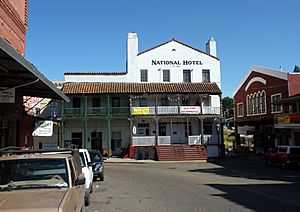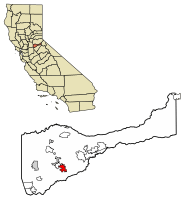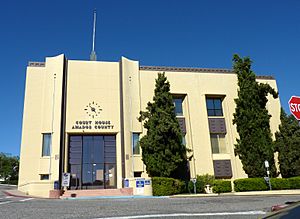Jackson, California facts for kids
Quick facts for kids
Jackson
|
||
|---|---|---|

Historic downtown Jackson
|
||
|
||
| Motto(s):
"Preserving our past, enriching our present, building our future"
|
||

Location of Jackson in Amador County, California.
|
||
| Country | ||
| State | ||
| County | Amador | |
| Settled | 1848 | |
| County Seat, Amador County | 1854 | |
| Incorporated | December 5, 1905 | |
| Area | ||
| • Total | 3.58 sq mi (9.27 km2) | |
| • Land | 3.58 sq mi (9.27 km2) | |
| • Water | 0.00 sq mi (0.00 km2) 0% | |
| Elevation | 1,217 ft (371 m) | |
| Population
(2020)
|
||
| • Total | 5,019 | |
| • Density | 1,402.0/sq mi (541.4/km2) | |
| Time zone | UTC-8 (PST) | |
| • Summer (DST) | UTC-7 (PDT) | |
| ZIP code |
95642
|
|
| Area code(s) | 209 | |
| FIPS code | 06-36980 | |
| GNIS feature IDs | 1658849, 2410128 | |
| Reference #: | 118 | |
Jackson is a city located in Amador County, California. It's also the county seat of Amador County, which means it's where the main government offices for the county are. Jackson has a rich history, especially from the California Gold Rush era.
The city was once known by several other names, including Botilleas and Bottle Spring. In 2020, about 5,019 people lived in Jackson. You can reach the city using State Route 49 and State Route 88.
Contents
Geography and Climate
Jackson covers an area of about 9.27 square kilometers (3.58 square miles). All of this area is land. Jackson Creek flows through the city. The soil in the area is often a type called Pardee cobbly loam.
What is Jackson's Climate Like?
Jackson has a hot-summer Mediterranean climate. This means it has hot, dry summers and mild, wet winters.
| Climate data for Jackson, 1991–2020 simulated normals (1243 ft elevation) | |||||||||||||
|---|---|---|---|---|---|---|---|---|---|---|---|---|---|
| Month | Jan | Feb | Mar | Apr | May | Jun | Jul | Aug | Sep | Oct | Nov | Dec | Year |
| Mean daily maximum °F (°C) | 55.4 (13.0) |
58.6 (14.8) |
62.6 (17.0) |
67.1 (19.5) |
76.3 (24.6) |
86.4 (30.2) |
93.4 (34.1) |
91.9 (33.3) |
86.7 (30.4) |
76.6 (24.8) |
63.9 (17.7) |
55.2 (12.9) |
72.8 (22.7) |
| Daily mean °F (°C) | 46.4 (8.0) |
48.7 (9.3) |
52.0 (11.1) |
55.2 (12.9) |
62.6 (17.0) |
70.3 (21.3) |
76.6 (24.8) |
75.9 (24.4) |
71.6 (22.0) |
63.1 (17.3) |
52.9 (11.6) |
46.2 (7.9) |
60.1 (15.6) |
| Mean daily minimum °F (°C) | 37.2 (2.9) |
38.8 (3.8) |
41.4 (5.2) |
43.5 (6.4) |
48.7 (9.3) |
54.5 (12.5) |
59.9 (15.5) |
59.9 (15.5) |
56.7 (13.7) |
49.6 (9.8) |
42.1 (5.6) |
37.0 (2.8) |
47.4 (8.6) |
| Average precipitation inches (mm) | 5.54 (140.84) |
5.34 (135.71) |
4.86 (123.33) |
2.94 (74.72) |
1.60 (40.74) |
0.40 (10.21) |
0.02 (0.47) |
0.04 (0.95) |
0.22 (5.61) |
1.61 (40.88) |
3.00 (76.26) |
5.40 (137.19) |
30.97 (786.91) |
| Average dew point °F (°C) | 38.1 (3.4) |
39.0 (3.9) |
41.7 (5.4) |
43.0 (6.1) |
45.9 (7.7) |
47.8 (8.8) |
49.8 (9.9) |
48.2 (9.0) |
45.5 (7.5) |
41.9 (5.5) |
40.5 (4.7) |
37.4 (3.0) |
43.2 (6.2) |
| Source: PRISM Climate Group | |||||||||||||
History of Jackson
Early Inhabitants
Before European settlers arrived, the area around Jackson was home to the Northern Sierra Indians. They lived near creeks and springs, often building villages on higher ground to avoid floods. These areas were also good for hunting and gathering food like acorns and grasses.
How Jackson Was Founded
Jackson was founded in 1848, during the California Gold Rush. It was named after a popular local lawyer, Colonel Alden Jackson. The town quickly grew because it was a good place for mining and a convenient stop for travelers going from Sacramento to the southern mining areas.
By 1850, Jackson had about 1,500 people. It became an important center for supplies and transportation. In 1854, Jackson became the county seat of the newly formed Amador County. Before that, it was the county seat for Calaveras County from 1851 to 1852.
Gold Mining in Jackson
At first, miners used placer mining, which means sifting gold from riverbeds. By the 1860s, hard rock mining became more common. This involved digging deep into the earth to find gold.
One of the most famous mines was the Kennedy Mine, which started in 1860. When it closed in 1942 during World War II, it was the deepest gold mine in North America, reaching 1,802 meters (5,912 feet) deep!
Another important mine was the Argonaut mine. On August 27, 1922, a fire broke out there, trapping 47 miners. Sadly, all 47 miners died, and it took over a year to recover the last body. This was the worst gold mine disaster in U.S. history.
In October 1942, the U.S. government stopped gold mining in California. This was because they needed men for the war, and gold was not considered a necessary metal for the war effort.
Important Landmarks
Jackson has several historical landmarks that tell its story:
- Argonaut and Kennedy Mines: These famous gold mines are recognized as California Historical Landmark No. 786.
- Jackson Gate: This area is named after a natural crack in the rock near Jackson Creek. In 1850, about 500 miners worked here. It's California Historical Landmark No. 118.
- Site of Jackson's Pioneer Jewish Synagogue: This was the site of the first synagogue in the Gold Country, built in 1857. It's California Historical Landmark No. 865. The Jackson Pioneer Jewish Cemetery is also connected to this history.
- Pioneer Hall: The Native Daughters of the Golden West organization was started here on September 11, 1886. It's California Historical Landmark No. 34.
Population and Community
| Historical population | |||
|---|---|---|---|
| Census | Pop. | %± | |
| 1880 | 1,040 | — | |
| 1910 | 2,035 | — | |
| 1920 | 1,601 | −21.3% | |
| 1930 | 2,005 | 25.2% | |
| 1940 | 2,024 | 0.9% | |
| 1950 | 1,879 | −7.2% | |
| 1960 | 1,852 | −1.4% | |
| 1970 | 1,924 | 3.9% | |
| 1980 | 2,331 | 21.2% | |
| 1990 | 3,545 | 52.1% | |
| 2000 | 3,989 | 12.5% | |
| 2010 | 4,651 | 16.6% | |
| 2020 | 5,019 | 7.9% | |
| 2021 (est.) | 5,101 | 9.7% | |
| U.S. Decennial Census | |||
Jackson's population has grown over the years. In 2000, there were 3,989 people, and by 2020, the population had increased to 5,019.
Jackson is known for having a large Serbian community. There is also a Serbian Orthodox church in the city.
High School
Jackson has one high school, called Argonaut High School. The school is named after the historic Argonaut Mine, which was located in the town.
Notable People
Many interesting people have connections to Jackson:
- Robert Grant Aitken, an astronomer
- John C. Begovich, a politician
- Anthony Caminetti, a politician
- Ernest Gallo, a famous winemaker
- James T. Farley, a politician
- Marie Suize, a French woman who became a gold miner in early Jackson
Images for kids
See also
 In Spanish: Jackson (California) para niños
In Spanish: Jackson (California) para niños












